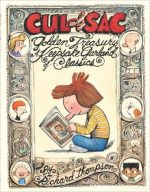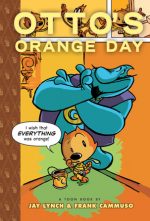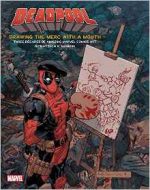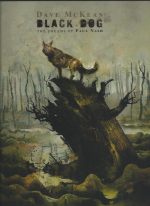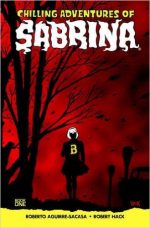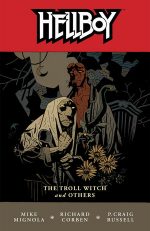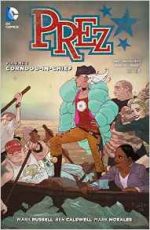
By Mark Russell, Ben Caldwell, Mark Morales, Dominike “Domo†Stanton & various (DC Comics)
ISBN: 978-1-4012-5979-2
I’ve been saving this fabulously funny, viciously satirical gem for the closing moments of an actual election, and now that my interference can’t possibly affect what has become the strangest and most contentious campaign in US history and the icing on the Great Big Cake celebrating the utter devaluation of democracy, I think it’s well past time to offer the world a different vision of leadership and governance before it’s too late…
It won’t change anything in the grand scheme of things, but at least we can comfortably shout “I told you so!†from the comfort of our cynicism-lined bunkers…
The original Prez was a hippie teenager created by comic book royalty. In the early 1970s Joe Simon made one of his irregular yet always eccentrically fruitful sojourns back to DC Comics, managing to sneak a bevy of exceedingly strange concepts right past the usually-conservative powers-that-be and onto the spinner racks and newsstands of the world.
Possibly the most anarchic and subversive of these was Prez, which postulated a time -approximately twenty minutes into the future – where teenagers had the vote and elected a diligent, naively idealistic young man who was every inch the hardworking, honest patriot every American politician claimed to be…
In 2015 that concept was given a devilishly adroit makeover for the post-millennial generation and the result was this superbly outrageous cartoon assessment of the State of the Nation.
As is the nature of the most effective social commentary (Slaughterhouse Five, Make Room! Make Room!, Stranger in a Strange Land, A Clockwork Orange, Rollerball, Judge Dredd, American Flagg!); although external trappings are futuristic and science fictional, the meat of the matter is all about Right Here, Right Now…
Originally released as the first six issues of a proposed 12-issue maxi-series, Prez: Corndog-In-Chief is written by Mark Russell (God Is Disappointed in You) and illustrated by Ben Caldwell (Justice League Beyond, Star Wars: Clone Wars). For a previously agreed fee, inks were provided by Mark Morales, Sean Parsons & John Lucas. Special mentions and congratulations should go to colourist Jeremy Lawson and especially letterers Travis Lanham, Marilyn Patrizio & Sal Cipriano whose efforts in supplying screen furniture, hilarious newsbleeds and strapline commentaries added so much to the overall feeling of helter-skelter information overload.
Take Note: on no account skip or skim the texts that scuttle across the bottom of these pages – just like a proper 24-hour TV news feed. Also, don’t read them whilst eating or drinking either. Laughing out loud and ejecting matter out of your nose is undignified and embarrassing…
In Washington DC the fix is always in. It’s 2036 and the election of the next President is being quietly decided by an elite group of Senators known as “the Colonelsâ€. Ultimate powerbroker Senator Thorn is addressing a crisis: the sitting incumbent has been scandalously “outed†and has withdrawn from the race with a week to polling day.
All alternatives for his position are pitiful and frankly embarrassing…
In Eugene, Oregon, 19-year-old Beth Ross is cleaning the grills and manages to deep-fry one of her pigtails. Naturally, her friends have the incident posted on the internet in seconds and she goes viral as “corndog girlâ€.
As the days count down the two main political parties swing into panic mode: sucking up to every media darling, publicity whore and news outlet in a frantic bid to get their particular privileged rich white guy elected. Thorn diligently pursues his own, welfare-cutting, businessman-rewarding, military-expanding schemes. He’s not that fussed about winning. He can do deals with anybody…
Beth meanwhile is considering going on a game show. It’s the only way to pay her father’s hospital bills. He’s dying of the new form of cat flu ravaging the nation and winning Double Dare Billionaire is the sole option left to her.
She doesn’t even make the final cut. It’s probably for the best: the winner had to shoot himself on live TV to get his cash…
Hacker Collective Anonymous meanwhile has started an internet campaign to get Corndog Girl onto the electoral ballot. Since Congress voted to allow Corporations the right to vote, all age restrictions have been abolished. Moreover, in a move to get people to participate, Congress has allowed the public to vote on Twitter…
Deeply embarrassed and paying no attention, Beth is astounded when she wins Ohio by a landslide and becomes a genuine contender…
‘The Democratic Circus’ has been a complete disaster for professional politicians. The Electoral College system has produced no clear winner and thus – due to the arcane and archaic rules of the process – moves to the House of Representatives where each State has one vote.
Thorn is finally in his element but has grievously underestimated the overwhelming personal greed of each Senator he tries to bribe. When the dirty pool, double-dealing and horse-trading reaches its peak his frustrated targets turn against him and before long the incorruptible (he knows because he and many others have already tried) Beth Ross is the Most Powerful Woman in the World.
In ‘Adventures in Cabinetry’ suddenly everybody in DC is breaking down her door, but the guy she listens too is Preston Rickard: the most despised man in politics. He suggests he be made Vice President. It’s the only way to save her life. No-one will have her assassinated if he’s next in line…
And so it goes as Beth, emboldened by idealism and the pointless death of her father, resolves to actually fix America. The first thing to do is select a cabinet of actual smart people and experts and join forces with the most brilliant inventor in the world.
Fred Wayne is also the world’s richest man: his unique algorithm made him enough cash to buy Delaware and disappear. With the advent of President Ross, however, Fred is once more interested in the world beyond his so very impassable doors…
Ross’ inauguration has everything: threats, more bribe offers, a spectacular assassination attempt and her first crisis. ‘The Beast of War’ details how increasing global tension results in a wave of bloodbaths.
America’s armies have been largely replaced by drones and robots; piloted by nerdy couch-potato slackers working from their own front rooms. Sadly, their tendency is to treat work like a gaming session, so with casualties from US drones skyrocketing, the Military-Industrial Complex are eager to move on to the next plateau.
Unfortunately for all concerned, the intelligent AI guiding robotic Sentry War Beast – as designed by Preferred Contractor Securi-Tech – is lethal, indestructible and has ideas uniquely her own.
Thorn cannot see a downside but he’s about to be very surprised again…
‘Apologies in Advance’ sees Beth decommission the entire drone Sentry Program and go on a world tour, apologising in person to every country the USA has subverted, invaded, insulted or strong-armed over its brief but checkered history. That brings its own dangers and ramifications but a domestic catastrophe is looking to be even more serious. Human deaths from feline flu are rocketing but “Big Pharma†wants certain promises before it will seek a cure. Their smug bubble bursts when President Ross again comes up with novel solution and makes a truly tough decision in ‘Beware of Cat’…
To Be Concluded…
Collecting Prez #1-6 – plus a short vignette of how Ross survived being shot down over the South Pacific seen in Sneak Peek: Prez #1 – this remarkable tome is peppered with delicious ironies and superb prognostications on the state of the union. Sinister undercurrents are provided by a cabal of masked billionaires in a Special Interest Group providing suitable Machiavellian menace whilst the progress of canny, sensible neophyte Ross pokes gaping holes in ideological Sacred Cows and sacrosanct ruling policies that have become the fundamentals of modern political thinking.
Most importantly Prez: Corndog-In-Chief offers a grimly hilarious and outrageously sardonic glimpse at how far it’s all gone wrong. To sweeten the pill it does come with a slush-fund filled with bonus features like a covers-& variants-gallery by Caldwell, Morales & Bret Blevins; Caldwell’s Prez Sketchbook, plus character designs, roughs, unused colour cover ideas and pencils by Dominike Stanton and Caldwell.
Funny, angry and delicious, this trenchant tale is one no fully enfranchised fan should miss.
© 2016 DC Comics. All Rights Reserved.

